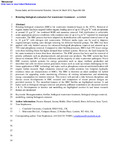JavaScript is disabled for your browser. Some features of this site may not work without it.
| dc.contributor.author | Hassard, Francis | |
| dc.contributor.author | Biddle, Jeremy R. | |
| dc.contributor.author | Cartmell, Elise | |
| dc.contributor.author | Jefferson, Bruce | |
| dc.contributor.author | Tyrrel, Sean F. | |
| dc.contributor.author | Stephenson, Tom | |
| dc.date.accessioned | 2016-03-04T09:37:39Z | |
| dc.date.available | 2016-03-04T09:37:39Z | |
| dc.date.issued | 2014-08-04 | |
| dc.identifier.citation | Hassard F, Biddle J, Cartmell E, et al., (2015) Rotating biological contactors for wastewater treatment – A review. Process Safety and Environmental Protection, Volume 94, March 2015, pp. 285-306 | en_UK |
| dc.identifier.issn | 0957-5820 | |
| dc.identifier.uri | http://dspace.lib.cranfield.ac.uk/handle/1826/9746 | |
| dc.identifier.uri | http://dx.doi.org/10.1016/j.psep.2014.07.003 | |
| dc.description.abstract | Rotating biological contactors (RBCs) for wastewater treatment began in the 1970s. Removal of organic matter has been targeted within organic loading rates of up to 120 g m−2 d−1 with an optimum at around 15 g m−2 d−1 for combined BOD and ammonia removal. Full nitrification is achievable under appropriate process conditions with oxidation rates of up to 6 g m−2 d−1 reported for municipal wastewater. The RBC process has been adapted for denitrification with reported removal rates of up to 14 g m−2 d−1 with nitrogen rich wastewaters. Different media types can be used to improve organic/nitrogen loading rates through selecting for different bacterial groups. The RBC has been applied with only limited success for enhanced biological phosphorus removal and attained up to 70% total phosphorus removal. Compared to other biofilm processes, RBCs had 35% lower energy costs than trickling filters but higher demand than wetland systems. However, the land footprint for the same treatment is lower than these alternatives. The RBC process has been used for removal of priority pollutants such as pharmaceuticals and personal care products. The RBC system has been shown to eliminate 99% of faecal coliforms and the majority of other wastewater pathogens. Novel RBC reactors include systems for energy generation such as algae, methane production and microbial fuel cells for direct current generation. Issues such as scale up remain challenging for the future application of RBC technology and topics such as phosphorus removal and denitrification still require further research. High volumetric removal rate, solids retention, low footprint, hydraulic residence times are characteristics of RBCs. The RBC is therefore an ideal candidate for hybrid processes for upgrading works maximising efficiency of existing infrastructure and minimising energy consumption for nutrient removal. This review will provide a link between disciplines and discuss recent developments in RBC research and comparison of recent process designs are provided (Section 2). The microbial features of the RBC biofilm are highlighted (Section 3) and topics such as biological nitrogen removal and priority pollutant remediation are discussed (Sections 4 and 5). Developments in kinetics and modelling are highlighted (Section 6) and future research themes are mentioned. | en_UK |
| dc.language.iso | en | en_UK |
| dc.publisher | Elsevier | en_UK |
| dc.subject | Bioaugmentation | en_UK |
| dc.subject | Biofilm | en_UK |
| dc.subject | Biological wastewater treatment | en_UK |
| dc.subject | Biological nitrogen removal | en_UK |
| dc.subject | Modelling | en_UK |
| dc.subject | Rotating biological contactor | en_UK |
| dc.title | Rotating biological contactors for wastewater treatment - A review | en_UK |
| dc.type | Article | en_UK |
Files in this item
This item appears in the following Collection(s)
-
Staff publications (SWEE) [2824]
